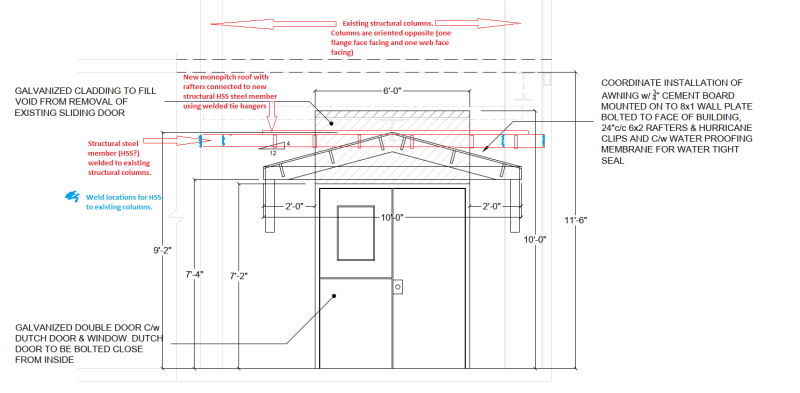Hi there,
I’m working on a project with a typical steel frame/cladding warehouse where the architect is trying to put a covering over a new door that will be installed. The covering was initially going to be a gable-pitched covering with timber rafters that were somehow going to be connected to the building's profiled sheet cladding. I’m not sure if that is typical but I felt more comfortable putting in a new structural element for the roof to attach to instead of the cladding, hence the proposed new HSS section that is welded to the existing columns.
To get this system to work, I proposed that they change the roof type to flat/mono pitch as shown in red, where the timber rafters could attach to the steel member HSS using welded joist hanger clips (HU26 Simpson strong ties or something similar depending on rafter size).
The existing building is a typical warehouse-type building with a profiled steel outer cladding.
This has brought about a few questions :
1. The outer cladding will need to have a hole cut to allow the timber rafters to attach through and connect to the joist hangers. How can the cladding around the rafters be sealed to prevent water ingress etc?
2. The two columns that the HSS section will be welded to are oriented in opposite planes (one with the web face facing and the other one flange face facing. If I weld (flare bevel groove welds) the HSS beam to the flanges as shown in the sketch below, what local failure modes should I be checking (the force is not very large, the covering is only extending 4’ out, although I do live in a hurricane prone country where the uplift pressure will be ~2.2kPa).
3. Is it typical that these types of small roof coverings just attach to the exterior steel cladding of warehouse buildings or am I overthinking this?
Sketch below :

Any help or advice would be greatly appreciated.
I’m working on a project with a typical steel frame/cladding warehouse where the architect is trying to put a covering over a new door that will be installed. The covering was initially going to be a gable-pitched covering with timber rafters that were somehow going to be connected to the building's profiled sheet cladding. I’m not sure if that is typical but I felt more comfortable putting in a new structural element for the roof to attach to instead of the cladding, hence the proposed new HSS section that is welded to the existing columns.
To get this system to work, I proposed that they change the roof type to flat/mono pitch as shown in red, where the timber rafters could attach to the steel member HSS using welded joist hanger clips (HU26 Simpson strong ties or something similar depending on rafter size).
The existing building is a typical warehouse-type building with a profiled steel outer cladding.
This has brought about a few questions :
1. The outer cladding will need to have a hole cut to allow the timber rafters to attach through and connect to the joist hangers. How can the cladding around the rafters be sealed to prevent water ingress etc?
2. The two columns that the HSS section will be welded to are oriented in opposite planes (one with the web face facing and the other one flange face facing. If I weld (flare bevel groove welds) the HSS beam to the flanges as shown in the sketch below, what local failure modes should I be checking (the force is not very large, the covering is only extending 4’ out, although I do live in a hurricane prone country where the uplift pressure will be ~2.2kPa).
3. Is it typical that these types of small roof coverings just attach to the exterior steel cladding of warehouse buildings or am I overthinking this?
Sketch below :

Any help or advice would be greatly appreciated.

